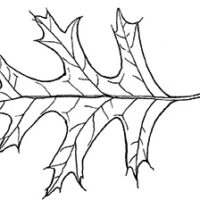 Purdue University - Extension - Forestry and Natural Resources
Purdue University - Extension - Forestry and Natural Resources
Got Nature? Blog
The classic and trusted book “Fifty Common Trees of Indiana” by T.E. Shaw was published in 1956 as a user-friendly guide to local species. Nearly 70 years later, the publication has been updated through a joint effort by the Purdue Department of Forestry and Natural Resources, Indiana 4-H, and the Indiana Department of Natural Resources, and reintroduced as “An Introduction to Trees of Indiana.”
The full publication is available for download for $7 in the Purdue Extension Education Store. The field guide helps identify common Indiana woodlot trees.
Each week, the Intro to Trees of Indiana web series will offer a sneak peek at one species from the book, paired with an ID That Tree video from Purdue Extension forester Lenny Farlee to help visualize each species as it stands in the woods. Threats to species health as well as also insight into the wood provided by the species, will be provided through additional resources as well as the Hardwoods of the Central Midwest exhibit of the Purdue Arboretum, if available.
This week, we take a look at the eighth of our featured oak varieties in Indiana, the Pin Oak or Quercus palustris.
The leaves of pin oak are multi-lobed, with lobes coming out at nearly a 90-degree angle from the center of the leaves, and feature bristle tips like all members of the red/black oak family. On the pin oak, the alternately held leaves typically have less lobes than other members of the red/black oak group. In the fall, leaves change from medium green to a red to reddish brown color.
One key characteristic of pin oak are the branches, which angle downward especially on the lower part of the tree. The pin oak tends to keep its lower branches for a long period of time, which can create pin knots in the wood.
The trunk of pin oak is typically straight and single stemmed, while the bark is smooth and gray and may develop dark fissures with age.
The fruit is a rounded acorn with a relatively flat top with smooth scales, which covers only about one quarter of the nut.
Pin oaks, which grow to 60 to 70 feet tall and are relatively fast growing, are found mostly in moist to wet areas, such as streams, lakes and other wetlands, oftentimes in soils that have a medium to high acidity. Pin oaks also have been planted in many sites for landscape purposes.
The natural range of the pin oak is in bottomlands and imperfectly drained soils from New Jersey south to Virginia and west to Eastern Kansas and Oklahoma as well as south into North Carolina, Tennessee and Arkansas.
The Morton Arboretum states that pin oak suffers greatly from chlorosis or yellowing of the leaves in soils with high pH. As with other oaks, the pin oak should be pruned in the dormant season to avoid attracting beetles that may carry oak wilt, which can be a potential disease problem along with oak blister.
For full article with additional photos view: Intro to Trees of Indiana: Pin Oak, Forestry and Natural Resources’ News.
If you have any questions regarding wildlife, trees, forest management, wood products, natural resource planning or other natural resource topics, feel free to contact us by using our Ask an Expert web page.
Other Resources:
ID That Tree: Pin Oak
ID That Tree: Red Oak Group
Hardwood Lumber and Veneer Series: Red Oak Group
Morton Arboretum: Pin Oak
Pin Oak, Native Trees of Indiana River Walk, Purdue Fort Wayne
Fifty Common Trees of Indiana
An Introduction to Trees of Indiana
Native Trees of the Midwest, The Education Store
Shrubs and Woody Vines of Indiana and the Midwest, The Education Store
Investing in Indiana Woodlands, The Education Store
Forest Improvement Handbook, The Education Store
ID That Tree, Purdue Extension-Forestry & Natural Resources (FNR) YouTube playlist
Woodland Management Moment , Purdue Extension-FNR YouTube playlist
Wendy Mayer, FNR Communications Coordinator
Purdue University Department of Forestry and Natural Resources
Lenny Farlee, Sustaining Hardwood Extension Specialist
Purdue University Department of Forestry and Natural Resources

Recent Posts
- Control Management of Poison Hemlock
Posted: May 7, 2025 in Invasive Plant Species, Plants, Wildlife, Woodlands - New Indiana Woodland Steward Newsletter, Stumpage Timber Price Report
Posted: May 3, 2025 in Forestry, Timber Marketing, Woodlands - ID That Tree: Black Raspberry
Posted: May 2, 2025 in Forestry, Urban Forestry, Woodlands - Publication – Goldenrod Control
Posted: April 30, 2025 in Forestry, Invasive Plant Species, Wildlife - White-tailed Deer Impact on Indiana Woodlands, Hoosier Ag Today
Posted: April 29, 2025 in Wildlife, Woodlands - Top 10 Spring Flowering Shrubs, Purdue Landscape Report
Posted: April 28, 2025 in Gardening, Plants, Urban Forestry - HTIRC Continues to Protect Our Hardwood Forests
Posted: April 18, 2025 in Forestry, Timber Marketing, Woodlands - Tips to Manage Storm-Damaged Trees, Purdue Landscape Report
Posted: April 17, 2025 in Forests and Street Trees, How To, Urban Forestry - Liz Jackson Receives IHLA’s President’s Award, Featured in ANR Newsletter
Posted: in Forestry, Timber Marketing, Wildlife, Wood Products/Manufacturing, Woodlands - A Woodland Management Moment: Bottomland Forests
Posted: in Forests and Street Trees, Urban Forestry, Wildlife, Woodland Management Moment, Woodlands
Archives
Categories
- Alert
- Aquaculture/Fish
- Aquatic/Aquaculture Resources
- Ask the Expert
- Christmas Trees
- Community Development
- Disease
- Drought
- Forestry
- Forests and Street Trees
- Gardening
- Got Nature for Kids
- Great Lakes
- How To
- Invasive Animal Species
- Invasive Insects
- Invasive Plant Species
- Land Use
- Natural Resource Planning
- Nature of Teaching
- Plants
- Podcasts
- Ponds
- Publication
- Safety
- Spiders
- Timber Marketing
- Uncategorized
- Urban Forestry
- Webinar
- Wildlife
- Wood Products/Manufacturing
- Woodland Management Moment
- Woodlands